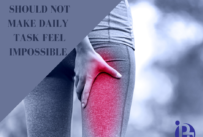Sciatica? Or Maybe Just A Pain In The Butt?

Most people know the term sciatica. Many have had the unpleasant symptoms which can range from an annoying gnawing ache in the buttock, possibly extending toward the foot, to the extreme of “OH MY GOSH! LIGHTNING BOLTS SHOOTING DOWN MY LEG!” Sciatica is quite often cited as a reason someone is unable to do something they might otherwise enjoy, as in “I normally would, but my sciatica is acting up”. It is mistakenly believed that sciatica cannot be helped or that it will just go away on its own. This false belief is a sure way to end up with chronic sciatica which will in fact limit many opportunities for enjoyment of activities or even day to day living.
The sciatic nerve is the longest nerve in the body. It’s as thick as a heavy duty extension cord and just like an electrical wire, but one that carries nerve impulses originating in the low back to many of the muscles in the hip, the back of the thigh and all of the way into the foot. Compression or injury anywhere along this nerve path will cause pain, weakness or numbness in these same areas or even further down the leg.
Due to the fact that the sciatic nerve covers such a large area the condition of sciatica may, by some, be easily misdiagnosed, leading to inaccurate treatment, including use of pain medications, invasive injections, expensive, time consuming or even painful tests and possibly surgery. This may prolong frustration and discomfort, but what’s worse may have a significant negative impact on the path of someone’s life. Faced with these options, it’s no wonder why some chose to ignore it or just try and live with it.
One reason why so many people suffer so long with sciatica is because the source of the symptoms can be elusive. Finding the true origin is the only way to truly solve the problem and not only make the symptoms go away, but also make you the strongest, most pain free version of yourself.
Typical characteristics of sciatic pain are that it is most often worse in sitting. This can be especially bad with driving, sitting on sports bleachers or even when on the toilet. It can be bad in the mornings, then may improve throughout the day, but then get worse again late afternoon when the muscles tire. This is opposed to spinal stenosis which tends to get worse with standing and walking.
Sciatica is most commonly thought to be caused by bulging spinal discs, but there are other conditions that may mimic sciatica. For one, spasms or trigger points in the low back and hip muscles may compress on the sciatic nerve. They may also refer pain that has nothing at all to do with the sciatic nerve. Another source may be a chronically strained or nagging hamstring. It is most certainly possible that both could be present and feeding each other. Sacro-iliac sprains or instability are yet another problem that can
Why not just get an MRI? MRI’s of the low back commonly find false positives and false negatives with symptomatic and asymptomatic people and should not be used as the primary diagnostic. They are best reserved for second opinions if conservative treatment is not working or if planning for surgery.
Our team of Doctors of Physical Therapy are experts at diagnosing and treating people with sciatica or similar symptoms. Here’s one of our go to exercises to help relieve sciatica:
Lie on your back with knees bent. Lace your fingers together behind one knee. Lift your leg up and gently push the heel to the sky for 2-3 seconds and then lower your leg down. Repeat 10 times on each leg. Repeat twice per day.
Visit www.SciaticaGetsBetterWithPT.com now to get instant access to our full Sciatica Relief Report, library of helpful videos, tips as well as options for a complimentary assessment to have all of your questions answered.
